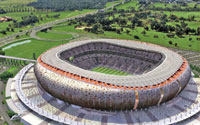
Visitor arrivals to South Africa were up by eight per cent to November compared with the same period in 2006. There was growth from most European markets with France up 9.6 per cent, Sweden up 7.6 per cent and Poland 26.6 per cent, while the largest European market, the UK, grew 2.4 per cent. Germany, the second largest European source, was a notable exception, declining by 2.2 per cent.
South African Tourism (SAT) noted that European leisure visitors were increasingly using South Africa as a gateway into southern Africa. Dual destination holidays were growing, particularly the South Africa/Mozambique combination.
The next few years promise even more growth, says SAT. A strong performance from the USA (+10.5 per cent) and Canada (+9.9 per cent) in the first 11 months of 2007 should continue, particularly as South Africa’s profile will get a strong boost when it hosts the American Society of Travel Agents’ (ASTA) convention for the first time in 2009. The FIFA World Cup in 2010 is also expected to attract many markets.
At Indaba 2008 held in Durban mid May Sibongile Mazibuko, the executive director of the City of Johannesburg, which is responsible for the planning and implementation of the 2010 programme, reported that the City is on track for the FIFA World Cup 2010.
“The biggest task was to get the construction on the stadiums going. To date, we have already passed the 50 per cent mark in relation to Soccer City which, when it is finished, will be one of the biggest stadiums in the world, seating around 87,000 people.”
Mazibuko says the construction of the roof frame for Soccer City has begun and the stadium will be completed by March 2009 as planned.
The City is also overseeing the upgrading of five other stadiums - Ellis Park, Orlando, Rand Stadium, Dobsonville and Ruimsig Stadiums.
“The Orlando stadium will be completed in the next three months,” Mazibuko said at the May meeting. “It is the oldest stadium in Soweto and it is where black professional football began for South Africa so it will be a historic moment when the upgraded stadium is finally opened for fans and players.”
Both the Ellis Park Stadium and the Soccer City stadium incorporate a precinct development as well as stadia upgrades.
“We are particularly excited about the Nasrec precinct development. Historically, the Nasrec area has been a buffer between the north and south of Joburg. So we are using the opportunity of the FIFA World Cup to transform the landscape of Joburg,” says Mazibuko.
The Nasrec precinct has four key focus areas: Soccer City, the International Broadcast Centre, a hotel, housing and commercial development plan and a new transport hub covering 340 kilometres of the city is being constructed at Nasrec. “The hub will include train, bus, and taxis. The SA Rail Commuter Corporation is refurbishing the Nasrec train station, and the Bus Rapid Transport link (BRT) will also stop at Nasrec,” Mazibuko said.
The BRT is a bus based transport system with dedicated routes for public and will go a long way to alleviating transport congestion experienced daily in the city. The BRT will become a feeder to Gautrain - a rapid rail transport system - and these together will link the OR Tambo International Airport to the Sandton precinct and the Rosebank precinct, she said.
Johannesburg will also be one of the host cities of the Confederations Cup in June 2009.
“We were lucky enough to be given the opportunity of hosting the opening and closing games of the Confederations Cup; as well as the Confederations Cup Final Draw which will take place in November this year. It will be unique opportunity to showcase our ability and preparedness for the following year when the 2010 FIFA World Cup will also see the opening and closing games held in Joburg.”
The FIFA corporate social programme, called Football for Hope, will also be hosted by Johannesburg five days before the final game of the 2010 FIFA World Cup. Alexandra will be the site of one of the 20 centres being built by FIFA in Africa.
